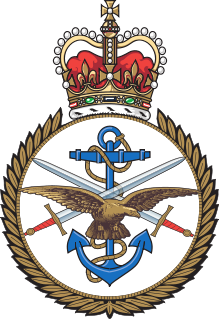
The Far East Fleet was a fleet of the Royal Navy which existed between 1952 and 1971.

The Home Fleet was a fleet of the Royal Navy that operated from the United Kingdom's territorial waters from 1902 with intervals until 1967.

The Atlantic Fleet was a naval fleet of the Royal Navy. It existed for two separate periods; 1909 until 1914, and then 1919 until 1932.

The Channel Fleet and originally known as the Channel Squadron was the Royal Navy formation of warships that defended the waters of the English Channel from 1854 to 1909 and 1914 to 1915.

British Forces Gibraltar is the British Armed Forces stationed in the British overseas territory of Gibraltar. Gibraltar is used primarily as a training area, thanks to its good climate and rocky terrain, and as a stopover for aircraft and ships en route to and from deployments East of Suez or Africa.

Fleet Operational Sea Training (FOST) is a Royal Navy training organisation.

The Reserve Fleet was a Royal Navy formation of decommissioned vessels which could be brought to a state of readiness at time of war.

The Admiral-superintendent, Portsmouth was the Royal Navy officer in command of the Naval Dockyard. Portsmouth from 1832 to 1971; prior to this date a resident Commissioner of the Navy Board had had oversight of the yard, since 1649. In May 1971 command responsibility for naval staff in the dockyard was merged into the wider local command structure, initially under the dual designation of Flag Officer, Portsmouth and Admiral Superintendent, Portsmouth but in July 1971 was again renamed Flag Officer Spithead and Port Admiral Portsmouth after a couple of months. These joint titles was used until 1975, and despite the name change the command still covered the same geographic area and operational responsibilities until 1996 when its ceased to exist as a separate command appointment and its responsibilities were assumed by the staff of Flag Officer First Flotilla.
Naval Home Command administered training and garrison functions for the Royal Navy from 1969-2012. Its commander was Commander-in-Chief, Naval Home Command (CINCNAVHOME).

The Admiral Commanding, Reserves, was a senior Royal Navy post that existed from 1875 to 1976.

The Naval Recruitment Training Agency (NRTA) originally called the Naval Training Department was first established in 1944 as a department within the Admiralty it underwent numerous name changes until 1 April 1995 as a new agency of the Navy Department of the British Ministry of Defence. Its role was to contribute to the operational capability of the United Kingdom Armed Forces by recruiting to the Naval Service, delivering training to the Defence community it was administered by the Chief Executive (NRTA)/Flag Officer, Training and Recruitment it was abolished in 2005.

The Royal Squadron originally known as the Royal Flotilla was an ad hoc naval formation of the British Royal Navy assembled for official visits and travel by sea by the British monarch. The squadron was commanded by the Flag Officer, Royal Yachts from 1660 to 1997.

The Assistant Chief of the Naval Staff (Personnel) is a senior Royal Navy appointment responsible for the sustainable delivery of sufficient, capable and motivated personnel to the Naval Service in support of Defence Outcomes; he does this on behalf of the First Sea Lord and Chief of the Naval Staff. It has now subsumed under Director People and Training.

The 2nd Cruiser Squadron was a formation of cruisers of the British Royal Navy from 1904 to 1919 and from 1921 to 1941 and again from 1946 to 1952.
The First Flotilla was a naval formation of the British Royal Navy commanded by the Flag Officer, First Flotilla from 1971 to 1990.
The Flag Officer, Surface Flotilla was a senior British Royal Navy appointment from 1990 to 2002.

The Commander United Kingdom Task Group was a senior Royal Navy operational appointment from April 1992 to March 2015. In March 2015 the post was renamed Commander Amphibious Task Group.

The Chief of Staff Navy Command (HQ) is a senior Royal Navy appointment is the principal staff officer responsible for coordinating the supporting staff of Navy Command Headquarters, Portsmouth, England. The office was established in June 2010.

The Flag Officer Plymouth was a senior Royal Navy appointment first established in July 1969. The office holder was responsible for the administration of. The appointment continued until 1996 when it was abolished.









